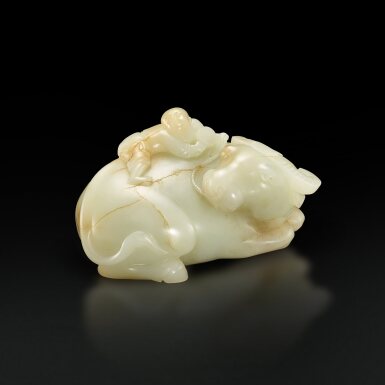Important Chinese Art
Important Chinese Art

The Victor Shaw Collection of Chinese Jades | 邵維錫藏中國玉雕
A white and russet jade 'boy and buffalo' group, Qing dynasty, 18th century | 清十八世紀 白玉童子牧牛
Auction Closed
October 9, 10:57 AM GMT
Estimate
500,000 - 700,000 HKD
Lot Details
Description
The Victor Shaw Collection of Chinese Jades
A white and russet jade 'boy and buffalo' group,
Qing dynasty, 18th century
邵維錫藏中國玉雕
清十八世紀 白玉童子牧牛
12.2 cm
The present lot is skilfully carved from a lustrous jade pebble of an even white tone. The auspicious scene depicting a small boy either riding or leading a water buffalo was one of the favourite themes of the rural idyll depicted by the Chinese painters during the Song dynasty. See a painting by Li Tang (1050-1130), Herd Boy with Water Buffalo and Calf, in the Taipei Palace Museum, illustrated in Ann Elizabeth Barrott Wicks, Children in Chinese Art, Honolulu, 2002, fig. 2.6.
The reclining buffalo, a symbol of strength and tranquillity, is also associated with spring and agriculture because of its role in pulling ploughs. According to James C.S. Lin in The Immortal Stone, Cambridge, 2009, p. 51, from the Ming dynasty buffaloes were often depicted at rest with its head turned 90 degrees, as seen in the present carving, to indicate that the world was at peace. When depicted with a young boy riding on its back, this motif represents obedience and serenity as well as spring and agriculture because of its role in pulling ploughs. Even a small child can ride an animal of this size and strength without fear.
Compare with a similar carving of smaller size from the Qing Court collection, illustrated in the Compendium of Collections in the Palace Museum: Jade, vol. 9: Qing Dynasty, Beijing, pl. 135.
白玉閃青,此件雕童子牧牛極為生動,不論臥牛或是童子的胴體刻畫,還是對其毛髮、表情的細節表現都恰如其分,足顯明清以來宮廷玉匠寫實玉雕的嫻熟工藝。童子牧牛題材最早流行於宋代田園生活題材畫作中,台北故宮博物院收藏李唐童子水牛及乳牛圖手卷(作於十一或十二世紀),載於 Ann Elizabeth Barrott Wicks 編,《Children in Chinese Art》,檀香山,2002年,圖2.6。
宋代以後,童子牧牛主題成為遠離世俗煩囂、禮儀及公務,追求簡樸生活之象徵。林政昇曾對童子牧牛之象徵意義做過討論,見《The Immortal Stone》,劍橋,2009年,頁51,作者認為自明代以來,見玉雕水牛頭以九十度轉向一邊,象徵天下太平,而牛背上騎一童子,則有潮氣勤懇、扭轉乾坤之意。
參考北京故宮博物院清宮舊藏一件清代青玉童子騎牛,尺寸稍小,著錄於《故宮博物院藏品大系.玉器篇》,卷9:清,北京,2011年,圖版135。
